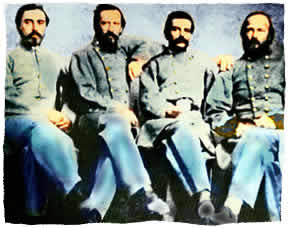|
Continued...Part 9
After
six arduous weeks of skirmishing, the troopers of the 3rd
Texas Cavalry went into camp on the 20th of July at Pelahatchie,
twenty-two miles from Jackson. Colonel Mabry, now recovered
from his wounds joined them. With time for rest, the 3rd Texas
Cavalry and the Texas Brigade received much needed supplies.
They found time to participate in a parade and there was a
formal ball held that they attended. Even though a rest was
ordered there was still duties of the cavalry that knew no
rest. During the "rest" the 3rd Texas was but on
picket duty, scouting and guard duty in addition to participation
to raids and skirmishes as each regiment was rotated to these
duties.

The
3rd Texas Cavalry was a very diverse cross section of Texas
Culture. Among the Officers of the 3rd Texas Cavalry were
from left to right, Refugio Benavides, Atanacio Vidaurri,
Cristobal Benavidez and John Z. Leyendecker. The cavalrymen
are dressed in the officer’s frock coat and are curiously
absent of their cavalry boots. By 1864 many Confederate cavalry
lacked boots and even shoes.It is suspected that this image
was taken late in the war.
On
August 15th, the Texas Brigade engaged elements of the Federal
forces sent out to destroy the remnants of the Rebel railroad.
The skirmishes were hot and heavy but the Texas Brigade found
itself terribly out numbered. It resolved itself to hit and
run tactics to delay the enemy. On September 28th, they again
hit the Federal Cavalry but with better results chasing them,
the pursued them back into the safety of their more larger
army. This occurred about five miles from the Yazoo River.
|
|
 |
|
Another
engagement occurred on the Morning of October 15th when some
9000 Yankee troops headed toward the Big Black River in an
effort to relieve forces near Canton, Mississippi. The battle
was fought near Canton where some 4000 of the mounted Texas
Brigade hit General McPherson’s advance. The battle developed
with General Whitfield’s Texas Brigade holding the high
ground in the wooded ravine overlooking the east bank of Bogue
Chitto Creek. Though out numbered, they pinned the Yankees
at the bottom of the creek with their artillery and small
arms. At dawn on the 16th, the Yankee infantry swarmed up
the hill. A second defensive position was set up and the defenders
fell back some five miles up the road. The rain began to fall
and the battle continued till nightfall. On October 18th the
Federals began to withdrawal as they were peppered by the
3rd Texas Cavalry and the Texas Brigade.
"Sul"
Ross’s Texas Brigade
General
Whitfield’s health soon became bad enough that he had
to be relieved of duty. Colonel Lawrence S. "Sul"
Ross was appointed commander of the Texas Brigade.
 |
General
Ross was only 25 years of age
at the time of his assumption of command. He was born
on September 27, 1838 in Bentonsport, Iowa. During his
Summer vacation from college, he would come to back to
Texas where he earned quite a reputation as an Indian
fighter. In 1858 he was commission a Captain in the Texas
Rangers by Same Houston. |
| He
further enhanced his reputation by rescuing Cynthia Ann
Parker and killing Comanche Chief Peta Nocona in an encounter
just prior to the Civil War. Sul Ross entered the ranks
of the 6th Cavalry regiment as a private but swiftly made
it up the ranks. On May 14, 1862 he was promoted to full
Colonel. He was promoted to Brigadier General on December
31, 1963. During the war Ross participated in 135 engagements
with the Texas Brigade and had five horses shot out from
under him. Sul Ross was to lead the Texas brigade well.
He turned the moral around, boosted the spirits of the
entire command and showed solid leadership. Taking command,
he soon turned the Texas Brigade back to a fighting force
to be reckoned with. It was "Ross’s Texas Brigade"
that the name stuck to and forever more, the veteran’s
referred to it thus. "Lawrence Sullivan" Ross
would be known as "Sul Ross" for the remainder
of his life which was not over by any means. He went on
to become Governor of the State of Texas in 1887. He served
two terms and was then appointed President of Texas A&M
University. A post he held until his death on January
8, 1898. He is buried in Waco, Texas. |

Part
1 | Part
2 | Part
3 | Part
4 |
Part 5
Part
6| Part
7 |
Part 8| Part
9 | Part
10
Part
11 |
Part 12 | Part
13
|
|